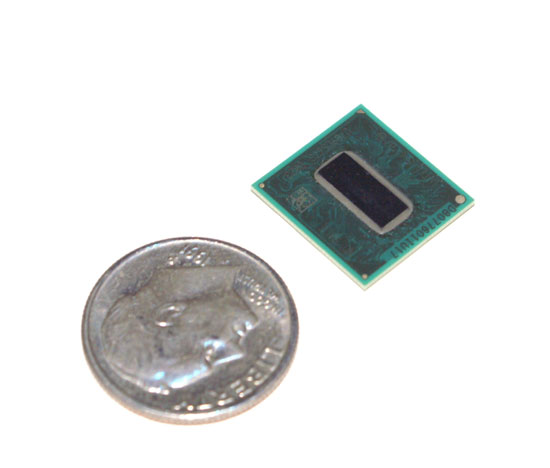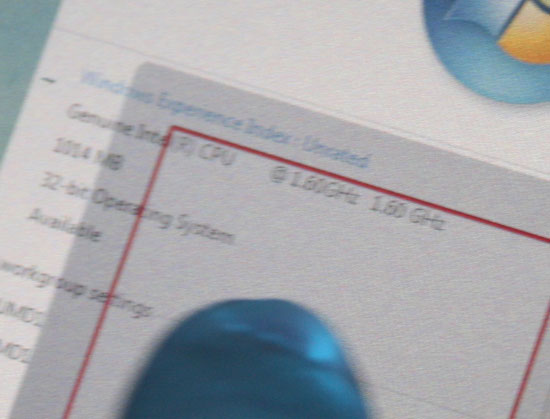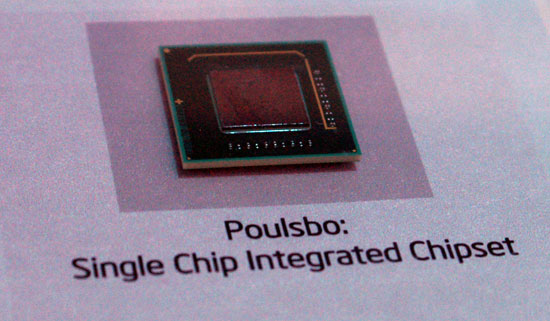Intel's Menlow Revealed: Baby Centrino Gets Ready
by Anand Lal Shimpi on January 9, 2008 12:00 AM EST- Posted in
- CPUs
As we wrote about at last year's IDF, Menlow is the name of this new ultra mobile platform that Intel is working on. In Intel's terms the platform refers to the CPU + chipset, much like how Centrino is a combination of an Intel CPU, Intel chipset and Intel wireless adapter.
The Menlow project began back in 2004, so what you're hearing about today is much like what Centrino was back in 2003. We're on the verge of something very big (I could insert a pun here about how Menlow is actually very small and it's ironic that it's also something very big, but I won't; you can thank me later).
Menlow consists of the Silverthorne processor and the Poulsbo chipset. If you're in dire need of yet another codename, the core used in Silverthorne is also known as Bonnenn.
Silverthorne is a brand new architecture, highly simplified from current Core 2 chips (thus reducing die size and power consumption) but still compatible. Silverthorne is an x86 chip, meaning it can run the same applications as your desktop and notebook; and it's technically ISA compatible with Merom (65nm Core 2 Duo), meaning it has support for up to SSE3 but lacks SSE4 instructions.


You can see the chip in the picture above; it's tiny. Because of its size you can guess that it's not a very complex core, and not full of cache, despite the obvious reductions in hardware Intel promises that Silverthorne will offer performance comparable to its 90nm Pentium-M from 2004.

We asked for clarification on these performance expectations as this wasn't the first time we'd heard it from Intel. What we got was a promise that Silverthorne, at launch, will be available in clock speeds that the Pentium M was in 2004 and at comparable performance levels as well. Looking back at our original review of the 90nm Pentium M from 2004 we see that the chip launched at frequencies ranging from 1.0GHz up to 2.0GHz. Intel actually had Silverthorne running at its CES booth, at clock speeds ranging from 600MHz to 1.6GHz.

Intel is targeting 10x lower power than its current ultra low voltage processors, meaning a TDP of 0.55 - 0.6W. These TDPs will be possible at the low end of the clock speed spectrum, which so far means 600MHz. The higher clocked parts will obviously consume more power, but Intel says that it'll still be significantly less than 5.5W.
From a performance standpoint, Intel is shooting for Dothan (90nm Pentium M) level performance in a 5" form factor with Menlow/Silverthorne.

While Silverthorne is built on a 45nm process its chipset, Poulsbo, isn't. We couldn't get confirmation on the manufacturing process but we'd suspect that it's at least 65nm, resulting in a much larger die than the Silverthorne processor itself as you can see from the pics above.










22 Comments
View All Comments
n0nsense - Sunday, January 13, 2008 - link
I don't like intel.Usually it does something good only when they have no other choice (like Core architecture).
The x86 is not good from the very beginning decades ago. But greater evil is there. It's name Microsoft. They just want you to use what they designed to get money from you instead of designing For You with user in mind.
And the only thing that make me smile, is expected percentage of devices based on this platform that will run MS products.
Actually Linux rules in mobile/efficient devices world.
As for the software compatibility on different platforms, Java does the job.
And the Linux world does know how to work with different platforms. Most distributions available for several architectures.
So, the most important thing is to have size/power/performance in right combination.
It will be very sad if intel will succeed to kill other architectures.
Boissez - Friday, January 11, 2008 - link
I've just checked the numbers... And I just can't see how this 47M transistor processor clocked slower than the 77M Pentium M can perform similarly.I know that there has been som architectural tweaks meanwhile... but still we're talking about a 3x improvement (assuming the 600mhz part=1000 Mhz Pentium M) - If those performance claims are true I'm inpressed.
IntelUser2000 - Friday, January 11, 2008 - link
Actually, most of the differences between the 47 million and 77 million is cache. If you look at the core alone, its not much different. Of course, it will impact performance...Pentium 2x8KB=3.1 million
Pentium Pro 2x8KB L1=5.5 million
Pentium II 2x16KB L1=7.5 million
Pentium III 2x16KB L1=9.5 million
Conroe/Merom 2x32KB L1=19 million
Silverthorne 32KB iL1, 24KB dL1=10 million??
Silverthorne's core transistor count is estimated at 10 million. Maybe it can perform like a Pentium III 512KB cache with SSE3. Anyway, it has 512KB L2 cache so...
IntelUser2000 - Saturday, January 12, 2008 - link
The estimated performance of Silverthorne:1.86GHz:
50-60% faster in multi-thread than A110
Similar in single thread to A110
1.1GHz:
A110 MT performance
A100 ST performance
(A100=600MHz/512KB/400MHz FSB/Dothan)
(A110=800MHz/512KB/400MHz FSB/Dothan)
When Intel says "similar" performance to 2004 notebooks, they are referring to ULVs. ULVs are clocked at 900MHz-1.1GHz. Take a look at Intel's technical documentations for their ULV processors. You'll notice that the performance increase has been almost flat even with the architectural/process improvements. They wouldn't have been able to make a 0.5W CPU without a substantial architectural overhaul.
Pentium M 130nm ULV
1.1GHz 7W 400MHz
Pentium M 90nm ULV
773 1.3GHz 5.5W 400MHz
Core Duo ULV
U2500 1.2GHz 9W 533MHz
Core Solo ULV
U1500 1.33GHz 5.5W 533MHz
Core 2 Duo ULV
U7600 1.33GHz-10W 533MHz
Core 2 Solo ULV
U2200 1.2GHz-5.5W 533Mhz
For two generations ahead in architecture and process technology, the latest ULV CPU offers much less than it does on desktops and laptops.
ajuez - Friday, January 18, 2008 - link
I think thet the Via C7-M ULV is similar in approach to the Silverthorne processor: very simple architecture focused on power consumption and cost.The VIA C7-M ULV consumes 3.5W (according to http://www.via.com.tw/en/products/processors/c7-m_...">http://www.via.com.tw/en/products/processors/c7-m_... )
However, Intel has the advantage of their manufacturing technology (Silverthorne is a 45nm processor, while C7 is a 90nm processor). I hope Via to update their processor with a better process (55nm?)
IntelUser2000 - Wednesday, January 16, 2008 - link
Maybe we are all confused after Intel introduced the Core 2 Duo. From what I can remember, its only worthy product that came out of the company for many years. All the chipsets after 865/875 were mediocre, and everything else is just a flop.I heard that Menlow is headed by the same guy that made a failed XScale and Itanium. Maybe its gonna be another flop. Currently, the only thing that Menlow is sure to bring is the size. Everything else, like battery life and performance is looking gloomy every day.
Flunk - Friday, January 11, 2008 - link
Way less cache, cache is the biggest use of transistors on chips designed for PCs. Cut the cache to say 256k (which is enough for a device running entirely off of flash) and you save a lot of transistors.TA152H - Friday, January 11, 2008 - link
What's processor cache got to do with Flash drives?Processor cache speeds up RAM accesses, RAM cache can be used (and is normally) to cache hard disk accesses, and that's probably what you're thinking of. But they're two different things.
I agree though, transistors are not the same as size. You can pack memory transistors much more closely than logic, and it can seriously impact transistor count while less seriously increasing the size (and cost) of the processor.
iwodo - Friday, January 11, 2008 - link
If Silverthrone is really that powerful i think it can used as a NAS Chip.All current NAS are so underpower and dont provide fast enough transfer due to CPU limitations. Windows Home Server kind of remove the performance barrier since it require Desktop class PC.
However they are also more power hungry too.
I hope Apple use this as their base for Apple Home server
Shadowmage - Thursday, January 10, 2008 - link
Anand:Nice article, but you spelled "Bonnell" wrong.
Menlow consists of the Silverthorne processor and the Poulsbo chipset. If you're in dire need of yet another codename, the core used in Silverthorne is also known as Bonnenn.